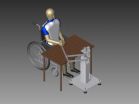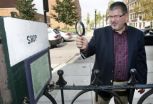(Press-News.org)
VIDEO:
This is about the worldwide patent for a Spanish stroke rehabilitation robot.
Click here for more information.
Robotherapist 3D, a robot which aids stroke patients' recovery, is to be brought to market by its worldwide patent holder, a spin-off company from the Miguel Hernández University of Elche (Alicante, Spain). It is the first robot to enable patients to start doing exercises while supine, allowing them to begin shortly after the stroke and expediting recovery.
The Biomedical Neuroengineering Group at the Miguel Hernández University of Elche in Alicante has recently established a spin-off technologies company, Instead Technologies. It was founded in order to market the robots they have developed to aid stroke patients' recovery, Nicolás García-Aracil, a founding member of the company, informs SINC.
The company, a leader in this field in Spain, already has two robots: Robotherapist 2D and Robotherapist 3D. For the latter, it has a worldwide patent. Both are actuated by pneumatic technology and have been designed to improve arm movement in stroke patients.
According to the researcher, Robotherapist 2D is a planar robot which allows movement in two dimensions and includes sensors to determine the patient's condition and a sound feedback system. "With this robot, certain tasks are carried out. The patient's arm is moved parallel to the table: to the right, to the left and in a straight line. They are exercises to improve coordination," he says.
Neuroplasticity
After a stroke, in addition to suffering from hemiplegia, patients will suffer from spasticity or muscle tightness. If patients cannot move their arm, the robot helps them lift it to a specific point. "These exercises improve neuroplasticity and re-establish damaged connections", the researcher explains.
Instead Technologies does not hold the patent on this system. "It is a pre-existing technology. What we are thinking of patenting though is the type of rehabilitation and care procedure which we are developing," adds García-Aracil.
Robotherapist 2D is already being trialled with a chronic stroke patient, "and the results are promising." They will now conduct a trial with patients from the rehabilitation unit of a public university hospital, before the robot is approved. "Some patients will receive conventional physiotherapy, while others will be treated with the help of the robot. The results will then be compared."
Daily tasks
The second robot developed by the Biomedical Neuroengineering Group is Robotherapist 3D, whose worldwide patent has been granted to Instead Technologies. This new machine helps patients to perform movements in all positions and directions. In addition, it has a virtual reality system so that people can start to carry out everyday tasks again, such as lifting a glass of water to their mouth.
The robot "allows you to follow all of the steps involved in rehabilitation, firstly with passive movements of the upper limbs. When you have reached a certain level of mobility, you continue with occupational therapy, performing everyday tasks such as eating and drinking, all by means of virtual reality," the researcher emphasises.
The company is financing the making of two prototypes and it has asked the Centre for Industrial Technological Development (CDTI), as well as a private hospital, for help in starting the trials in public and private hospitals.
The only one of its kind in Spain
Prior to the establishment of Instead Technologies, there were no companies in Spain which specialised in rehabilitation robots. And they are few and far between in the world in general. The main such companies are the Swiss company Hocoma and the US company Interactive Motion Technologies.
This gap in the market inspired some members of the Biomedical Neuroengineering Group at the Miguel Hernández University of Elche to create a spin-off company, with the aim of bringing their own robots to market: Robotherapist 2D and Robotherapist 3D. Their target users are public and private hospitals and rehabilitation clinics in Europe and emerging Latin American countries, according to Nicolas García-Aracil, group researcher and founding member of its company.
The company consists of five team members who are experts in the fields of medicine, IT, engineering, biology and biochemistry. There is also a sixth external member; a professional from the health industry whose identity remains confidential.
At present, the company is focussing on robots which facilitate stroke recovery, however it is also collaborating with associations linked with other diseases: Parkinson's, Alzheimer's and multiple sclerosis. "In general, these robots can be used to help rehabilitate people who have suffered brain damage or those who are in the early stages of a neurodegenerative disease," García-Aracil explains.
According to this researcher, although Robotherapist 3D is the most recent robot, both are valuable in different types of rehabilitation.
INFORMATION:
References:
Badesa, Francisco; Morales, Ricardo; Garcia-Aracil, Nicolas; Sabater, Jose M.; Perez-Vidal, Carlos; Fernandez, Eduardo. "Multimodal interfaces to improve therapeutic outcomes in robot-assisted rehabilitation". IEEE Transactions on Systems, Man, and Cybernetics--Part C.
Ricardo Morales, Francisco Javier Badesa, Nicolás García-Aracil, José María Sabater, Carlos Pérez-Vidal. "Pneumatic robotic systems for upper limb rehabilitation". "Journal: Medical and Biological Engineering and Computing,1-12". Springer Berlin/Heidelberg.
Worldwide patent for a Spanish stroke rehabilitation robot
2012-10-09
ELSE PRESS RELEASES FROM THIS DATE:
River Thames invaded with foreign species
2012-10-09
Almost 100 freshwater species not native to the UK have invaded the River Thames catchment making it one of the most highly invaded freshwater systems in the world, according to scientists at Queen Mary, University of London.
The research, published in the journal Biological Invasions at the weekend, suggests that legislation to prevent the introduction of non-native species across the UK has been unsuccessful. The cost to the British economy of invasive non-native species is £1.7bn every year (CABI report, 2010).
Lead author, Dr Michelle Jackson* who undertook the ...
VIB concludes that Séralini study is not substantiated
2012-10-09
The scientific analysis in this document shows that the research design of Séralini et al. contained fundamental shortcomings that preclude any sensible conclusions from being drawn. In other words, the statements that Séralini made about the health effects of GMOs and Roundup were baseless. Moreover, the research shows signs of selective interpretation of the findings or a misleading representation of these, which is contrary to prevailing scientific ethical standards.
###View the entire analysis online: http://www.vib.be/en/news/Pages/VIB-concludes-that-Seralini-study-is-not-substantiated-.aspx
...
A system to automate traffic fines is designed
2012-10-09
This press release is available in Spanish. The goal of the scientists in the Information and Communications Technology Security Group (Seguridad de las Tecnologías de la Información y las Comunicaciones - SeTI) at UC3M who are working on the E-SAVE project is to use information technologies (ITs) to improve the enforcement of certain traffic regulations. Specifically, they propose a set of systems for the automated, immediate and telematic supervision and management of the administrative sanctioning process. The purpose is to reduce highway accidents, given that one of ...
Researchers develop new way to determine amount of charge remaining in battery
2012-10-09
Researchers from North Carolina State University have developed a new technique that allows users to better determine the amount of charge remaining in a battery in real time. That's good news for electric vehicle drivers, since it gives them a better idea of when their car may run out of juice.
The research is also good news for battery developers. "This improved accuracy will also give us additional insight into the dynamics of the battery, which we can use to develop techniques that will lead to more efficient battery management," says Dr. Mo-Yuen Chow, a professor ...
UC research finds small signs lead to big frustrations
2012-10-09
Signs that are too small or unclear to consumers seem to be a growing national issue, leading some business owners to lose potential customers, according to University of Cincinnati Marketing Professor James Kellaris.
"This persistent, growing national problem is frustrating for consumers and can lead to loss of business and, by extension, loss of tax revenue for the community," Kellaris said.
Kellaris, the James S. Womack/Gemini Chair of Signage and Visual Marketing in the UC Carl H. Lindner College of Business, will present this research during the October 10 -11 ...
Cause of annoyance, concern, anxiety, and even anger:
2012-10-09
To understand the effects of continuous computerized surveillance on individuals, a Finnish research group instrumented ten Finnish households with video cameras, microphones, and logging software for personal computers, wireless networks, smartphones, TVs, and DVDs. The twelve participants filled monthly questionnaires to report on stress levels and were interviewed at six and twelve months. The study was carried out by Helsinki Institute for Information Technology HIIT, a joint research institute of Aalto University and the University of Helsinki, Finland.
The results ...
Southampton researchers explain how pulsars slow down with age
2012-10-09
Researchers at the University of Southampton have developed a model which explains how the spin of a pulsar slows down as the star gets older.
A pulsar is a highly magnetised rotating neutron star which was formed from the remains of a supernova – an explosion which happens after a massive star runs out of nuclear fuel. A pulsar emits a rotating beam of electromagnetic radiation, rather like that of a lighthouse. This beam can be detected by powerful telescopes when it points towards and sweeps past the Earth.
Pulsars rotate at very stable speeds, but slow down as ...
Researchers examine how teachers can increase students' interest and engagement in the classroom
2012-10-09
The National Center for Educational Statistics reported that only 73% of high school freshmen graduate within four years. For those students who continue their education at the collegiate level, slightly more than half (57%) earn a bachelor's degree and over 18% will leave college altogether. Although many factors can contribute to students' academic risk, negative emotions associated with learning—such as a lack of interest and engagement in their courses—could be a vital reason for students' disengagement, withdrawal, and failure in school.
Joseph Mazer's article, published ...
Making computer data storage cheaper and easier
2012-10-09
Businesses and consumers may soon have a simple, cheaper way to store large amounts of digital data.
Case Western Reserve University researchers have developed technology aimed at making an optical disc that holds 1 to 2 terabytes of data – the equivalent of 1,000 to 2,000 copies of Encyclopedia Britannica. The entire print collection of the Library of Congress could fit on five to 10 discs.
The discs would provide small- and medium-sized businesses an alternative to storing data on energy-wasting magnetic disks or cumbersome magnetic tapes, the researchers say. To ...
Demographic miracle in the deserts
2012-10-09
This press release is available in German.
Using demographic methods, ecologist Roberto Salguero-Gómez investigates desert plants to find out how vulnerable they are to climate change. The results of his newest study are surprising: Climate change may have a positive impact on some plants.
Climate models used by scientists to forecast the effect of climate change on the various ecosystems predict a bleak future for these regions: temperatures will rise, there will be less rain, and it will rain more erratically – all conditions seemingly unfavorable to plants.
To ...


